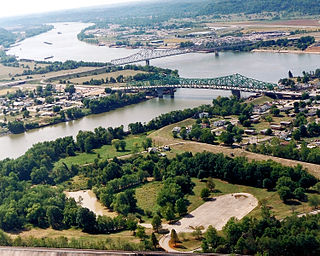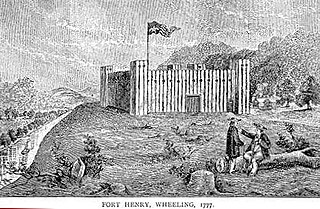
Harrodsburg is a home rule-class city in Mercer County, Kentucky, United States. It is the seat of its county. The population was 9,064 at the 2020 census.

Point Pleasant is a city in and the county seat of Mason County, West Virginia, United States, at the confluence of the Ohio and Kanawha Rivers. The population was 4,101 at the 2020 census. It is the principal city of the Point Pleasant micropolitan area extending into Ohio. The town is best known for the Mothman, a purported humanoid creature reportedly sighted in the area that has become a part of West Virginia folklore.

Lord Dunmore's War, also known as Dunmore's War, was a brief conflict in fall 1774 between the British Colony of Virginia and the Shawnee and Mingo in the trans-Appalachian region of the colony south of the Ohio River. Broadly, the war included events between May and October 1774. The governor of Virginia during the conflict was John Murray, 4th Earl of Dunmore, who in May 1774, asked the House of Burgesses to declare a state of war with the Indians and call out the Virginia militia.

Fort Henry was a colonial fort which stood about ¼ mile from the Ohio River in what is now downtown, Wheeling, West Virginia. The fort was originally known as Fort Fincastle and was named for Viscount Fincastle, Lord Dunmore, Royal Governor of Virginia. Later it was renamed for Patrick Henry, and was at the time located in Virginia. The fort was subject to two major sieges, two notable feats and other skirmishes.

The Battle of Point Pleasant, also known as the Battle of Kanawha and the Battle of Great Kanawha, was the only major action of Dunmore's War. It was fought on October 10, 1774, between the Virginia militia and Shawnee and Mingo warriors. Along the Ohio River near modern-day Point Pleasant, West Virginia, forces under the Shawnee chief Cornstalk attacked Virginia militiamen under Colonel Andrew Lewis, hoping to halt Lewis's advance into the Ohio Valley. After a long and furious battle, Cornstalk retreated. After the battle, the Virginians, along with a second force led by Lord Dunmore, the Royal Governor of Virginia, marched into the Ohio Valley and compelled Cornstalk to agree to a treaty, which ended the war.
Lewis Wetzel was an American scout and frontiersman. Because of how feared he was by the Native American Tribes, he was nicknamed "Death Wind". He stood about 6 ft with dark brown hair. He was an expert with a knife and tomahawk and was even deadlier with a black powder rifle, or musket. While running at full speed, Death Wind could load powder from his powder horn, a ball round and pack it, aim it and fire with expert marksmanship every time. Raised in what is now the Northern Panhandle of West Virginia, his exploits were once hailed as similar to those of Daniel Boone.

Cornstalk was a Shawnee leader in the Ohio Country in the 1760s and 1770s. His name in the Shawnee language was Hokoleskwa. Little is known about his early life. He may have been born in the Province of Pennsylvania. In 1763, he reportedly led a raid against British American colonists in Pontiac's War. He first appears in historical documents in 1764, when he was one of the hostages surrendered to the British as part of the peace negotiations ending Pontiac's War.

Andrew Lewis was an Irish-born American surveyor, military officer and politician. Born in County Donegal, he moved with his family to the British colony of Virginia at a young age. A colonel in the Virginia militia during the French and Indian War, and brigadier general in the American Revolutionary War, his most famous victory was the Battle of Point Pleasant in Dunmore's War in 1774, although he also drove Lord Dunmore's forces from Norfolk and Gwynn's Island in 1776. He also helped found Liberty Hall in 1776.
This is a timeline of Kentucky history.

Fort Randolph was an American Revolutionary War fort which stood at the confluence of the Ohio and Kanawha Rivers, on the site of present-day Point Pleasant, West Virginia, United States.

James Harrod was a pioneer, soldier, and hunter who helped explore and settle the area west of the Allegheny Mountains. Little is known about Harrod's early life, including the exact date of his birth. He was possibly underage when he served in the French and Indian War, and later participated in Lord Dunmore's War. He also rose to the rank of colonel in the local militia.

James John Floyd was an early settler of St. Matthews, Kentucky, and helped lay out Louisville. In Kentucky, he served as a Colonel of the Kentucky Militia in which he participated in raids with George Rogers Clark and later became one of the first judges of Kentucky.
Edward Worthington was an Irish-born American frontiersman, hunter, surveyor and soldier who explored and later helped settle the Kentucky frontier. A veteran of the American Revolutionary War and the American Indian Wars, he also served as a paymaster under George Rogers Clark during the Illinois campaign. His grandson, William H. Worthington, was an officer with the 5th Iowa Volunteer Infantry Regiment during the American Civil War. Historian and author, Kathleen L. Lodwick is a direct descendant of Edward Worthington.
Col. Johannes "John" Bowman was an 18th-century American pioneer, colonial militia officer and sheriff, the first appointed in Lincoln County, Kentucky. In 1781 he also presided as a justice of the peace over the first county court held in Kentucky. The first county-lieutenant and military governor of Kentucky County during the American Revolutionary War, Col. Bowman also, served in the American Revolution, many times, second in command to General George Rogers Clark, during the Illinois Campaign, which, at the time, doubled the size of the United States.

The Yellow Creek massacre was a killing of several Mingo Indians by Virginian settlers on April 30, 1774. The massacre occurred across from the mouth of the Yellow Creek on the upper Ohio River in the Ohio Country, near the current site of the Mountaineer Casino, Racetrack and Resort. It was the single most important incident contributing to the outbreak of Lord Dunmore's War. It was carried out by a group led by Jacob Greathouse and Daniel Greathouse. Daniel Greathouse died of measles the following year, and Jacob Greathouse was killed in an ambush in 1777. The other perpetrators were never brought to justice.
William Ward was the founder of Urbana, Ohio, and one of the original settlers in Kentucky's Mason County and Ohio's Mad River Valley.

Lewis Magisterial District is one of ten magisterial districts in Mason County, West Virginia, United States. The district was originally established as a civil township in 1863, and converted into a magisterial district in 1872. In 2020, Robinson District was home to 5,635 people.
Silas Harlan was one of the early settlers of Kentucky, having arrived with James Harrod in 1774 to found Harrodstown – the oldest permanent white settlement in the territory. Silas spent the majority of the American Revolution on the frontier fighting against Native Americans, however, near the end of his life, he served under George Rogers Clark through the Illinois Campaigns of 1779 and died at the Battle of Blue Licks on August 19, 1782, fighting a mixed band of Native and British troops.

David Glenn was of Irish descent and was born in 1753, likely in Pennsylvania but possibly in Virginia. He was one of the early settlers of Kentucky having accompanied James Harrod in founding Harrodstown in 1774, along with his older brother, Thomas. Today, Harrodsburg is considered the oldest permanent white settlement in Kentucky, being it was settled almost a full year before Boonesborough.
Thomas Ingles was a Virginia pioneer, frontiersman and soldier. He was the son of William Ingles and Mary Draper Ingles. He, his mother and his younger brother were captured by Shawnee Indians and although his mother escaped, Thomas remained with the Shawnee until age 17, when his father paid a ransom and brought him back to Virginia. He later served in the Virginia militia, reaching the rank of colonel by 1780.















